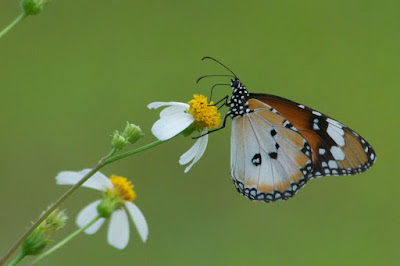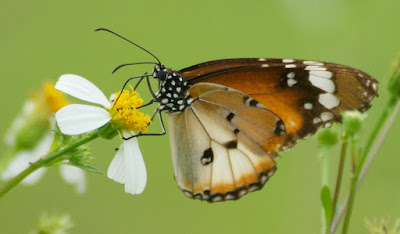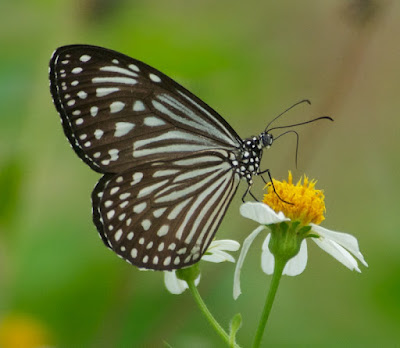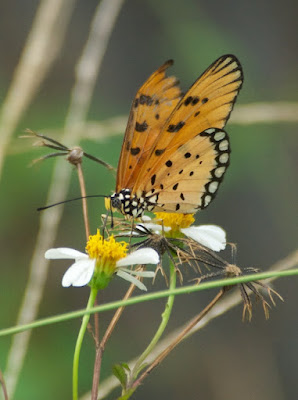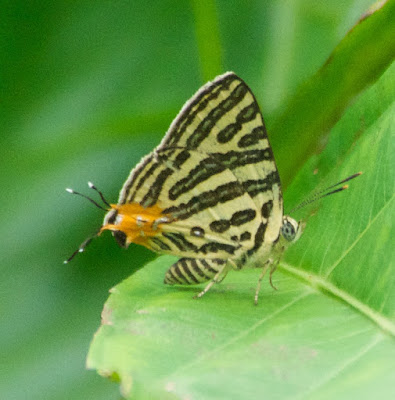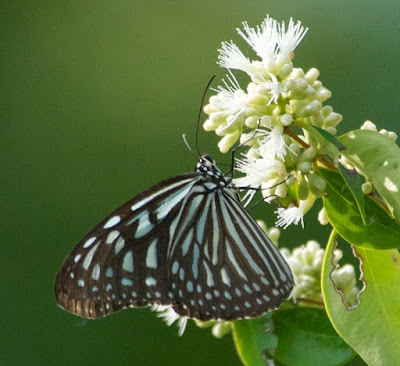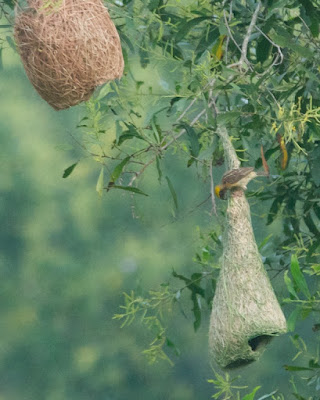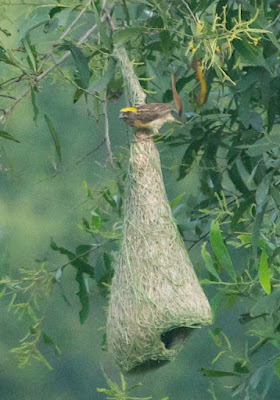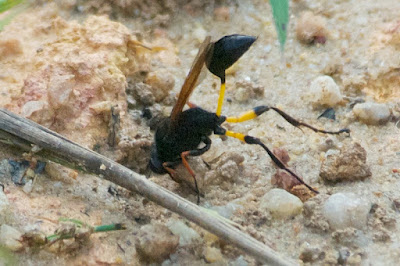Royce was in for a difficult siege - months of treatment at three Singapore hospitals, NUH, KK Women's and Children's Hospital and Mount Elizabeth, followed by a year with us in Canada under the care of Toronto's Hospital for Sick Children. I am happy to say that he is now in remission, back home in Kuching, and a very happy little boy. My very deep thanks to Royce's entire medical team - it's been a long haul, but at least we can now hope for the best. Here's Royce on his fourth birthday at our home in Mississauga, February 9, 2016.
Naturally, I did not intend or expect that our dash to Singapore would be for a nature-watching trip. Nonetheless, I decided that the best way to preserve a positive attitude would be to bring my binoculars and camera gear, in the expectation that I would have a chance to use them as Royce went on to recovery. Thanks to our cousins Chris and Susan Chang and their daughter Cynthia, I had the chance only the second day after I arrived.
Eileen spent the first weekend at the hospital, but we decided that as visitors were limited I should stay back until Monday when Royce was to undergo surgery. On the late afternoon of July 5th, 2014, Chris, Susan, Cynthia and I used our time to visit Tampines Eco Green, a fairly new reserve at the eastern end of Singapore Island. It was a welcome way to throw off both jet lag and, for at least a short time, worry.
The reserve is a combination of woods, open country and marshy ponds bordered with a local cattail (Typha angustifolia). It proved to be a very good place for a short nature break - check out this thorough writeup by a young Singapore naturalist.
Eileen spent the first weekend at the hospital, but we decided that as visitors were limited I should stay back until Monday when Royce was to undergo surgery. On the late afternoon of July 5th, 2014, Chris, Susan, Cynthia and I used our time to visit Tampines Eco Green, a fairly new reserve at the eastern end of Singapore Island. It was a welcome way to throw off both jet lag and, for at least a short time, worry.
The reserve is a combination of woods, open country and marshy ponds bordered with a local cattail (Typha angustifolia). It proved to be a very good place for a short nature break - check out this thorough writeup by a young Singapore naturalist.
We had barely arrived when we found numbers of butterflies visiting flowers at the reserve entrance.
The park is a good spot for birding, even if some of the more obvious, like the lizard, are exotics (lots of Javan Mynas (Acridotheres ) and Red-breasted Parakeets (Psittacula ), for example). The park has been deliberately planted with fruiting trees and others that attract birds like these Sunda Pygmy Woodpeckers (Dendrocopos moluccensis).
A few weeks later, On August 3, 2014, we returned to Tampines Eco Green - this time with Ryan, who had come over from Kuching to visit his brother, in tow.
Butterflies, including this Dark Glassy Tiger, were still busy feeding.
Among them was this Painted Jezebel (Delias hyparete), a member of one of the most (if not the most) diverse butterfly genera. There are about 250 species, ranging from India to Australia. This is Singapore's only resident species, though another, the Red-base Jezebel (D. pasithoe), has been recorded as a stray.
Baya Weavers were much further along on their construction projects than on my previous visit. Obviously nest-building, and nest-guarding, are priority male activities even in August, months before the start of the breeding season. For a male weaver, nests are critical in attracting females, and for that you can't start too soon.
Ceriagrion cerinorubellum is known as the Ornate Coraltail - not a bad name! Despite their beauty and delicacy these are voracious insects. They even devour each other on occasion.
Other insects we came across included this little mantid....
...and a mud dauber wasp (Sceliphron sp.) searching for nesting material. She will fill her solitary nest with paralyzed spiders, a living larder for her brood.
From the tiny and fascinating to the large and spectacular - I managed a quick snap of this White-bellied Sea-Eagle (Haliaeetus leucogaster), surely the largest of the birds of Tampines Eco Green, just as it took off.
Tampines Eco Green attracts a lot of Singaporeans, but not always for the same reasons as mine. Ryan, Susan and I found these two gentlemen releasing plastic bags full of fishes, bought from an aquarium store, into the central ponds. As they didn't speak English I was unable to discover why they we're doing what they were doing, but I suspect that they were either animal lovers, or Buddhists seeking to make merit by releasing an animal, or both. Unfortunately, the fishes that they were releasing were exotic aliens: mollies, swordtails and like, native to Mexico and Central America. I can understand that their hearts were in the right place, but introducing yet more exotics into the already-stressed Singapore ecosystem is not, I'm afraid, a good idea.
Plain Tigers (Danaus c. chrysippus) were particularly common, probably because the reserve managers had planted the area with its larval food plant, the Giant Milkweed (Calotropis gigantea).
In a single clump of flowers around the entrance sign we found a lovely, if slightly ragged, Blue Pansy (Junonia orithya wallacei), presumably the survivor of a narrow escape from a hungry bird...
... and a butterfly that was far less familiar to me, the Tawny Coster (Acraea violae). This is a particularly interesting insect, a representative of the genus that is widespread and diverse in Africa, but with far fewer representatives in other parts of the world.
The Tawny Coster is a recent arrival in Singapore, first recorded there only in 2006. It is now common, apparently (according to Khew Sin Khoon's A Field Guide to the Butterflies of Singapore) because of the widespread distribution of it's larval food plant, Passiflora foetida. However, this plant - locally known as Stinking Passionflower - is actually a native of the Americas, so in using it the Tawny Coster has made an evolutionary shift - though perhaps not a great one, as in other parts of its range Tawny Coster caterpillars eat a wide range of food plants, including native passionflowers.
Much less obvious - tiny and unobtrusive, actually - were two grass blues (Zizina). Based on the pattern of spots on the underside, I believe that these are Lesser Grass Blues (Zizina otis lampa), a common Singapore species.
I am usually pretty terrible with skippers, but comparison with the excellent photographs in Butterflies of Singapore I am more than usually confident that this is a Small Branded Swift (Pelopidas m. mathias). Of course, now someone will tell me that I've got it wrong...
As we walked down the trail, Susan and Cynthia called my attention to a most interesting and attractive little butterfly: a Club Silverline (Spindasis syama terana), Sitting quietly and most cooperatively on a leaf at a high-level. Apparently, this butterfly is not only uncommon in Singapore (though frequently seen at Tampines Eco Green), but normally spends most of its time flitting actively about and, presumably, not posing for nature photographers.
It is one of the hairstreaks, and the combination of an orange blotch and a pair of tails at the end of each hindwing are presumably there to convince hungry birds that this, and not the insect's real head, is the place they should focus their attack. Cynthia and Susan, although not particularly interested in butterflies as cuisine, were fooled in precisely the same way.
The illusion that this was indeed the head was even more realistic than this photograph might suggest, because the butterfly seems to have the ability, though I don't know how it manages it, to move its "tails" independently as though they were wiggling antennae.
Singapore, like (for example) Miami, is full of exotic species - everything from plants and birds to lizards. This is one of them - a female Changeable or Oriental Garden Lizard (Calotes versicolor), a rather large and agile reptile that reminded me of the common Green Crested Lizard (Bronchocela cristatella) I see frequently in Malaysia.
Here's another, perched on a clump of flowers. Males develop red throats in the breeding season, earning them the otherwise-undeserved name "bloodsucker". The species is widespread in Southern Asia and Indochina, and even occurs naturally on nearby Sumatra, but it is an exotic on Singapore.
The park is a good spot for birding, even if some of the more obvious, like the lizard, are exotics (lots of Javan Mynas (Acridotheres ) and Red-breasted Parakeets (Psittacula ), for example). The park has been deliberately planted with fruiting trees and others that attract birds like these Sunda Pygmy Woodpeckers (Dendrocopos moluccensis).
The park is apparently a good woodpecker spot; besides these little Sundas, we also found a pair of Common Goldenbacks (Dinopium javense), but the birds gave me no chance for a photograph.
One bird gave me quite a start. I spotted a couple if tiny black balls of fluff poking around on the grass at the edge of a cattail bed. I knew they were young rails, but didn't realize which species until their parent stepped out of the reeds. It was a Slaty-breasted Rail (Gallirallus striatus), a shy and skulking bird of which I had had, only once before in Brunei, but the briefest glimpse.
Unfortunately I failed to get a photo of the young birds, but the adult - though it soon disappeared back into the reeds - was a splendid, and totally unexpected, surprise.
We tracked a very persistent call to a juvenile Black-naped Oriole (Oriolus chinensis) still demanding attention from its parent.
Black-naped Orioles are abundant city birds in Singapore and Peninsular Malaysia, but they are, for some reason, extremely rare in Borneo so I 'm always glad of a chance to see them. Besides, they are, besides being abundant, spectacular birds.
In a shrub bordering a stretch of open water we found half a dozen nests of the Baya Weaver (Ploceus philippinus) in various stages of construction or disrepair, with at least one adult male and a few juveniles or females in residence. There were no nests in operating condition, but then the breeding season - from December to March in Singapore - was long over.
Tampines Eco Green centres on a number of ponds, some ringed with sedges and reeds.
Here are more invasives: Golden Apple Snails (Pomacea canaliculata), their presence betrayed by their clusters of bright pink eggs above the waterline....
...and another introduction from America, the Red-eared slider (Pseudemys scripta elegans).
Tampines Eco Green centres on a number of ponds, some ringed with sedges and reeds.
Here are more invasives: Golden Apple Snails (Pomacea canaliculata), their presence betrayed by their clusters of bright pink eggs above the waterline....
...and another introduction from America, the Red-eared slider (Pseudemys scripta elegans).
A few weeks later, On August 3, 2014, we returned to Tampines Eco Green - this time with Ryan, who had come over from Kuching to visit his brother, in tow.
Butterflies, including this Dark Glassy Tiger, were still busy feeding.
Among them was this Painted Jezebel (Delias hyparete), a member of one of the most (if not the most) diverse butterfly genera. There are about 250 species, ranging from India to Australia. This is Singapore's only resident species, though another, the Red-base Jezebel (D. pasithoe), has been recorded as a stray.
Baya Weavers were much further along on their construction projects than on my previous visit. Obviously nest-building, and nest-guarding, are priority male activities even in August, months before the start of the breeding season. For a male weaver, nests are critical in attracting females, and for that you can't start too soon.
This Oriental Garden Lizard (as compared with the animals I saw on my earlier visit) demonstrates why these animals are often called Changeable Lizards in Singapore. Differences in colour pattern may reflect the lizard's mood.
Given that the park features (and advertises) it's freshwater wetlands, I expected to see plenty of dragonflies there. To my surprise I saw very few - just a couple of common species, including this Brachydiplax chalybea (known in Singapore as the Blue Dasher, the same name we use in North America for the very similar Pachydiplax longipennis),
Other insects we came across included this little mantid....
...and a mud dauber wasp (Sceliphron sp.) searching for nesting material. She will fill her solitary nest with paralyzed spiders, a living larder for her brood.
From the tiny and fascinating to the large and spectacular - I managed a quick snap of this White-bellied Sea-Eagle (Haliaeetus leucogaster), surely the largest of the birds of Tampines Eco Green, just as it took off.
Tampines Eco Green attracts a lot of Singaporeans, but not always for the same reasons as mine. Ryan, Susan and I found these two gentlemen releasing plastic bags full of fishes, bought from an aquarium store, into the central ponds. As they didn't speak English I was unable to discover why they we're doing what they were doing, but I suspect that they were either animal lovers, or Buddhists seeking to make merit by releasing an animal, or both. Unfortunately, the fishes that they were releasing were exotic aliens: mollies, swordtails and like, native to Mexico and Central America. I can understand that their hearts were in the right place, but introducing yet more exotics into the already-stressed Singapore ecosystem is not, I'm afraid, a good idea.







